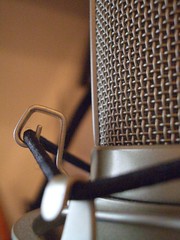Podcasting advice
Permalinks to this entry: individual page or in monthly context. For more material from my journal, visit my home page or the archive.
 Last night we recorded the first episode of Lip Gloss and Laptops, the new health, beauty, and cosmetics podcast by my wife and her friend K.A.
Last night we recorded the first episode of Lip Gloss and Laptops, the new health, beauty, and cosmetics podcast by my wife and her friend K.A.
UPDATE: Over on Dori and Tom's site, I was so absorbed in reading about Tom's return from the hospital that I completely missed Dori's links to the Wise-Women podcast tutorial. And Todd Cochrane's book on podcasting would certainly be a good read too, though I haven't checked it out personally yet.
The gear
The way the session worked was that the hosts spent the past week or so doing research and prep, then went over their notes while I set up the technical end, which consists of:
- Our eMac, now set up in the same basement studio where I record my own instrumental tunes.
- A new M-Audio FireWire 410 audio interface, which just arrived yesterday, almost a month after I ordered it—which is a whole other story I'll relate in a later journal entry.
- Two condenser microphones: an MXL 990 (photo) (part of the package with the M-Audio interface) and a Samson C01 (borrowed from work) on boom stands.
- GarageBand software to record their voices.
The session
Once we had everything set up and levels checked, I left the room, shut several doors for sound isolation, and went upstairs to wrangle our two daughters and K.A.'s son, to try to keep the noise levels down. It took a couple of false starts before the hosts got comfortable, but eventually they laid down a single continuous 20-minute take that was quite good, and which we'll upload for subscription on March 1.
As engineer and cable rassler, I spent part of this morning mixing their vocals with music and promos from other podcasters, and tweaking levels, then sent it to the hosts for approval. Since I had received the M-Audio interface and MXL mic not an hour before we set up, I didn't quite know how they worked and made a few mistakes in my setup, so I had to use the Audacity sound editor to do some more in-depth sound editing, which shouldn't be necessary for future episodes now that I know better what I'm doing.
Resources and advice
Although I have lots of experience recording music and my own solo voice, I haven't previously done anything like this podcast—which has two others hosting it, and which we are trying to give better-than-average sound quality. So in prepping for the session, I used some handy online resources to help figure out what I needed to know:
- Doug Kaye's audio processing advice for the volunteers at IT Conversations.
- His suggestions for setting up Skype interviews (would also work with iChat), which we haven't done yet but may in the future. That's the kind of setup diabeticfeed used when they interviewed me a few weeks ago.
- O'Reilly.com has links to more information (with Doug Kaye yet again) about what pioneering podcasters do: part 1, part 2, part 3, and part 4.
- Podcastrigs.com, a great site about stuff, most of which I will never, ever buy.
- Finally, IT Conversations' Podcast Academy recordings, so far including talks about advanced editing, mobile devices, and gearhead geek-outs.
The last session implies that I should probably hook up a dbx 266XL compressor/gate to the chain before our next session. Why that particular model? Because I already own it and it's stored in a portable rack case in the same recording room—we use it in my band for the bass drum on my kit, and otherwise it's just sitting on a shelf in the meantime.
In the long run, I'll probably want to get something like this to make the editing and mixing process smoother.







